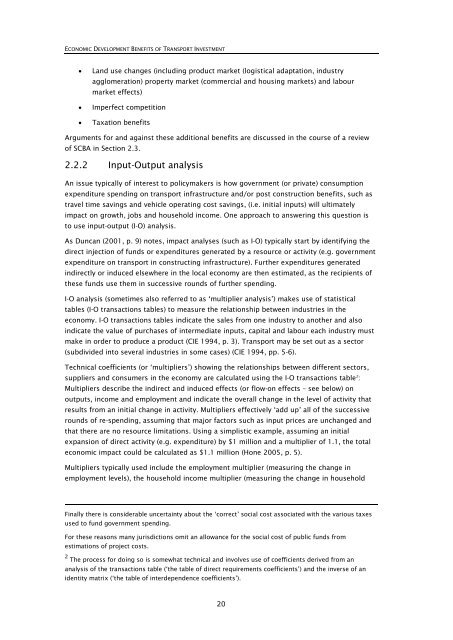Research 350 - NZ Transport Agency
Research 350 - NZ Transport Agency
Research 350 - NZ Transport Agency
You also want an ePaper? Increase the reach of your titles
YUMPU automatically turns print PDFs into web optimized ePapers that Google loves.
ECONOMIC DEVELOPMENT BENEFITS OF TRANSPORT INVESTMENT<br />
• Land use changes (including product market (logistical adaptation, industry<br />
agglomeration) property market (commercial and housing markets) and labour<br />
market effects)<br />
• Imperfect competition<br />
• Taxation benefits<br />
Arguments for and against these additional benefits are discussed in the course of a review<br />
of SCBA in Section 2.3.<br />
2.2.2 Input-Output analysis<br />
An issue typically of interest to policymakers is how government (or private) consumption<br />
expenditure spending on transport infrastructure and/or post construction benefits, such as<br />
travel time savings and vehicle operating cost savings, (i.e. initial inputs) will ultimately<br />
impact on growth, jobs and household income. One approach to answering this question is<br />
to use input-output (I-O) analysis.<br />
As Duncan (2001, p. 9) notes, impact analyses (such as I-O) typically start by identifying the<br />
direct injection of funds or expenditures generated by a resource or activity (e.g. government<br />
expenditure on transport in constructing infrastructure). Further expenditures generated<br />
indirectly or induced elsewhere in the local economy are then estimated, as the recipients of<br />
these funds use them in successive rounds of further spending.<br />
I-O analysis (sometimes also referred to as ‘multiplier analysis’) makes use of statistical<br />
tables (I-O transactions tables) to measure the relationship between industries in the<br />
economy. I-O transactions tables indicate the sales from one industry to another and also<br />
indicate the value of purchases of intermediate inputs, capital and labour each industry must<br />
make in order to produce a product (CIE 1994, p. 3). <strong>Transport</strong> may be set out as a sector<br />
(subdivided into several industries in some cases) (CIE 1994, pp. 5-6).<br />
Technical coefficients (or ‘multipliers’) showing the relationships between different sectors,<br />
suppliers and consumers in the economy are calculated using the I-O transactions table 2 :<br />
Multipliers describe the indirect and induced effects (or flow-on effects – see below) on<br />
outputs, income and employment and indicate the overall change in the level of activity that<br />
results from an initial change in activity. Multipliers effectively ‘add up’ all of the successive<br />
rounds of re-spending, assuming that major factors such as input prices are unchanged and<br />
that there are no resource limitations. Using a simplistic example, assuming an initial<br />
expansion of direct activity (e.g. expenditure) by $1 million and a multiplier of 1.1, the total<br />
economic impact could be calculated as $1.1 million (Hone 2005, p. 5).<br />
Multipliers typically used include the employment multiplier (measuring the change in<br />
employment levels), the household income multiplier (measuring the change in household<br />
Finally there is considerable uncertainty about the ‘correct’ social cost associated with the various taxes<br />
used to fund government spending.<br />
For these reasons many jurisdictions omit an allowance for the social cost of public funds from<br />
estimations of project costs.<br />
2 The process for doing so is somewhat technical and involves use of coefficients derived from an<br />
analysis of the transactions table (‘the table of direct requirements coefficients’) and the inverse of an<br />
identity matrix (‘the table of interdependence coefficients’).<br />
20
















